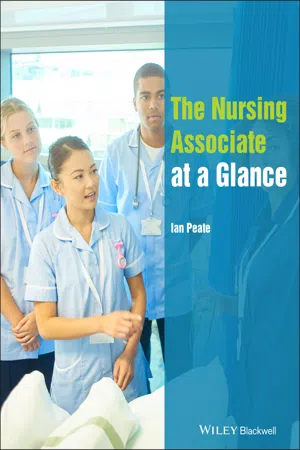
- English
- ePUB (mobile friendly)
- Available on iOS & Android
The Nursing Associate at a Glance
About this book
Everything you need to know about The Nursing Associate ... at a Glance!
The Nursing Associate at a Glance is a comprehensive guide developed to support trainee nursing associates with revision and practice-based learning, helping readers to uphold and maintain their Code of Conduct, promote healthy behaviours, treat ill health, and provide and monitor care effectively. Aligned with the six Nursing and Midwifery Council standards of proficiency for nursing associates, the book provides indispensable information about a range of areas of care including:
- How to contribute to integrated care, including how to be resilient and how to understand the various roles of health and social care teams
- How to improve the safety and quality of care, including an examination of health and safety legislation and the use of risk assessment tools
- How to effectively work in teams, including positive interaction with other members of the care team and how to manage data
- How to provide and monitor care, including discussions of deteriorating, anxious and confused patients
Perfect for trainee nursing associates seeking to successfully graduate from the nursing associate programme, The Nursing Associate at a Glance provides readers with the skills and knowledge required to be competent, confident and compassionate nursing associates.
Frequently asked questions
- Essential is ideal for learners and professionals who enjoy exploring a wide range of subjects. Access the Essential Library with 800,000+ trusted titles and best-sellers across business, personal growth, and the humanities. Includes unlimited reading time and Standard Read Aloud voice.
- Complete: Perfect for advanced learners and researchers needing full, unrestricted access. Unlock 1.4M+ books across hundreds of subjects, including academic and specialized titles. The Complete Plan also includes advanced features like Premium Read Aloud and Research Assistant.
Please note we cannot support devices running on iOS 13 and Android 7 or earlier. Learn more about using the app.
Information

Platform 1
Being an accountable practitioner
1
The Code

Top Tip
The Code
Prioritise people
Practise effectively
Preserve safety
Promote professionalism and trust
Table of contents
- Cover
- Table of Contents
- Series Page
- Title Page
- Copyright Page
- Preface
- Acknowledgements
- Platform 1: Being an accountable practitioner
- Platform 2: Promoting health and preventing ill health
- Platform 3: Provide and monitor care
- Platform 4: Working in teams
- Platform 5: Improving safety and quality of care
- Platform 6: Contributing to integrated care
- Appendix (i): Appendix (i)Annexes A and B (NMC, 2018)
- References and bibliography
- Index
- End User License Agreement